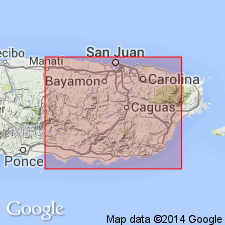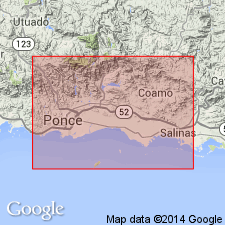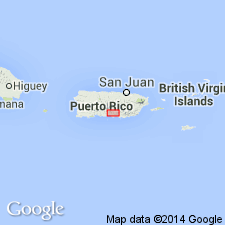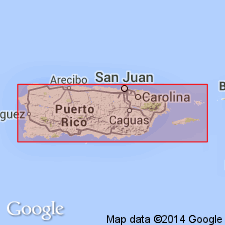
- Usage in publication:
-
- Los Puertos†
- Modifications:
-
- Abandoned
- AAPG geologic province:
-
- Caribbean region
Summary:
Aymamon limestone, here named, consists of dense white, gray, buff, and rose limestone of uniform lithology and bedding. Overlies Aguada limestone; top is eroded. Includes units formerly termed the Quebradillas and Los Puertos limestones in northwest Puerto Rico.
Source: GNU records (USGS DDS-6; Reston GNULEX).

- Usage in publication:
-
- Los Puertos member*
- Modifications:
-
- Reinstated
- Revised
- AAPG geologic province:
-
- Caribbean region
Summary:
Los Puertos member, named by Hubbard (1920) and replaced by the Aymamon limestone by Zapp and others (1948), is here assigned to the base of the Naranjo formation of the Jacaguas group. Unconformably overlies Cretaceous units; grades upward into Coamo Springs limestone member. Age is early middle Eocene.
Source: GNU records (USGS DDS-6; Reston GNULEX).

- Usage in publication:
-
- Los Puertos Member*
- Modifications:
-
- Revised
- AAPG geologic province:
-
- Caribbean region
Summary:
The Jacaguas Group of Pessagno (1960a) is here adopted, as well as the Miramar, Guayo, and Rio Descalabrado Members of the Naranjo Formation of Pessagno (1960a) and the Los Puertos Member of the Naranjo of Pessagno (1960b). The Naranjo Formation and its Coamo Springs Limestone Member and the Augustinillo Formation and its Collores and Monserrate Members are not adopted or discussed. The Raspaldo Formation is here named in the Jacaguas and the Cuevas Limestone of Glover (1961) is assigned to the Jacaguas. Formations are, in ascending order: Miramar, Los Puertos, Raspaldo, disconformity, Cuevas, Guayo, Rio Descalabrado. Unconformably overlies the Coamo Formation; unconformably underlies the Juana Diaz Formation. Age is Late Cretaceous (Maastrichtian) to middle Eocene. Authors state that Los Puertos is here named, but it may be the name of Hubbard (1920). Age is early Paleocene and may be in part early Eocene.
Source: GNU records (USGS DDS-6; Reston GNULEX).

- Usage in publication:
-
- Los Puertos Formation*
- Modifications:
-
- Age modified
- AAPG geologic province:
-
- Caribbean region
Summary:
The Los Puertos Formation occurs in central Puerto Rico and consists of andesitic volcaniclastic breccia. Unit is distinguished from the Coamo Formation by presence of locally interbedded quartz-bearing dacitic tuff. Maximum estimated thickness is 350 meters. The age of the Los Puertos is changed to early Paleocene.
Source: GNU records (USGS DDS-6; Reston GNULEX).
For more information, please contact Nancy Stamm, Geologic Names Committee Secretary.
Asterisk (*) indicates published by U.S. Geological Survey authors.
"No current usage" (†) implies that a name has been abandoned or has fallen into disuse. Former usage and, if known, replacement name given in parentheses ( ).
Slash (/) indicates name conflicts with nomenclatural guidelines (CSN, 1933; ACSN, 1961, 1970; NACSN, 1983, 2005, 2021). May be explained within brackets ([ ]).

